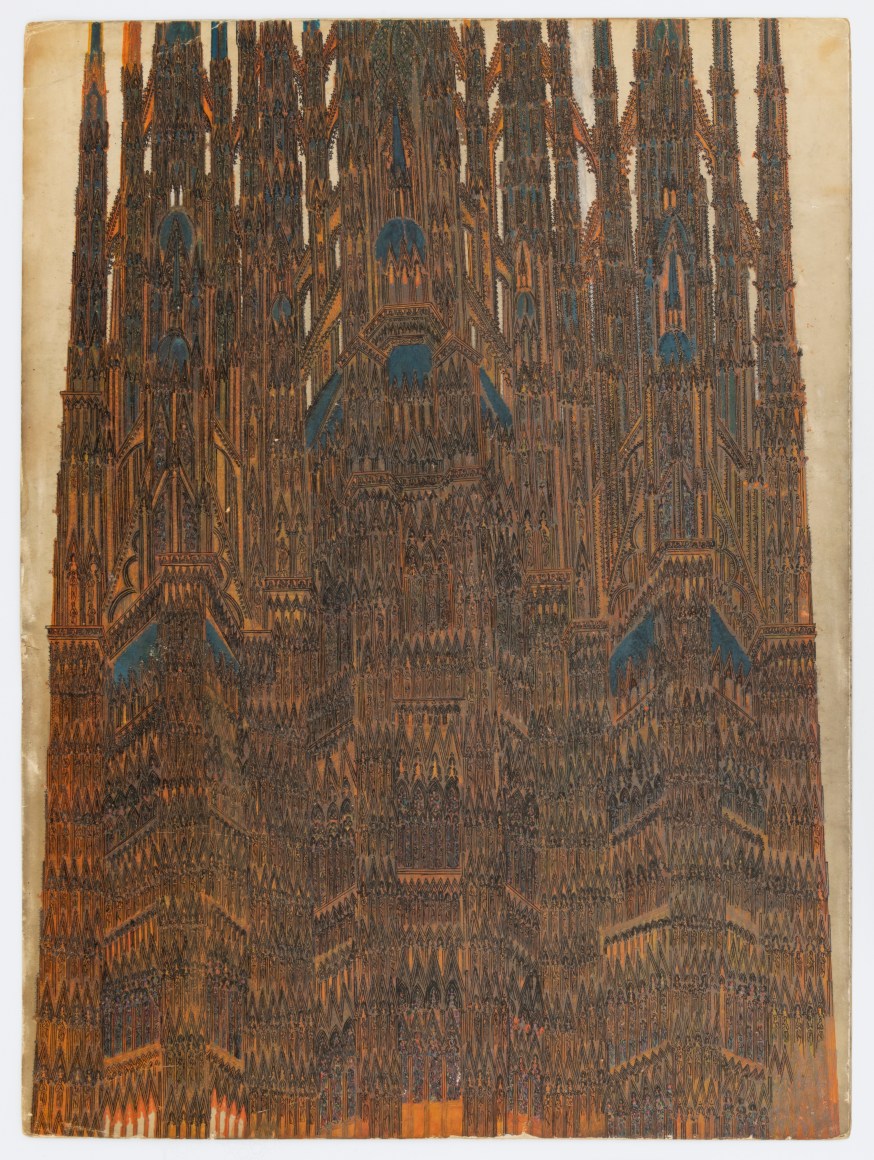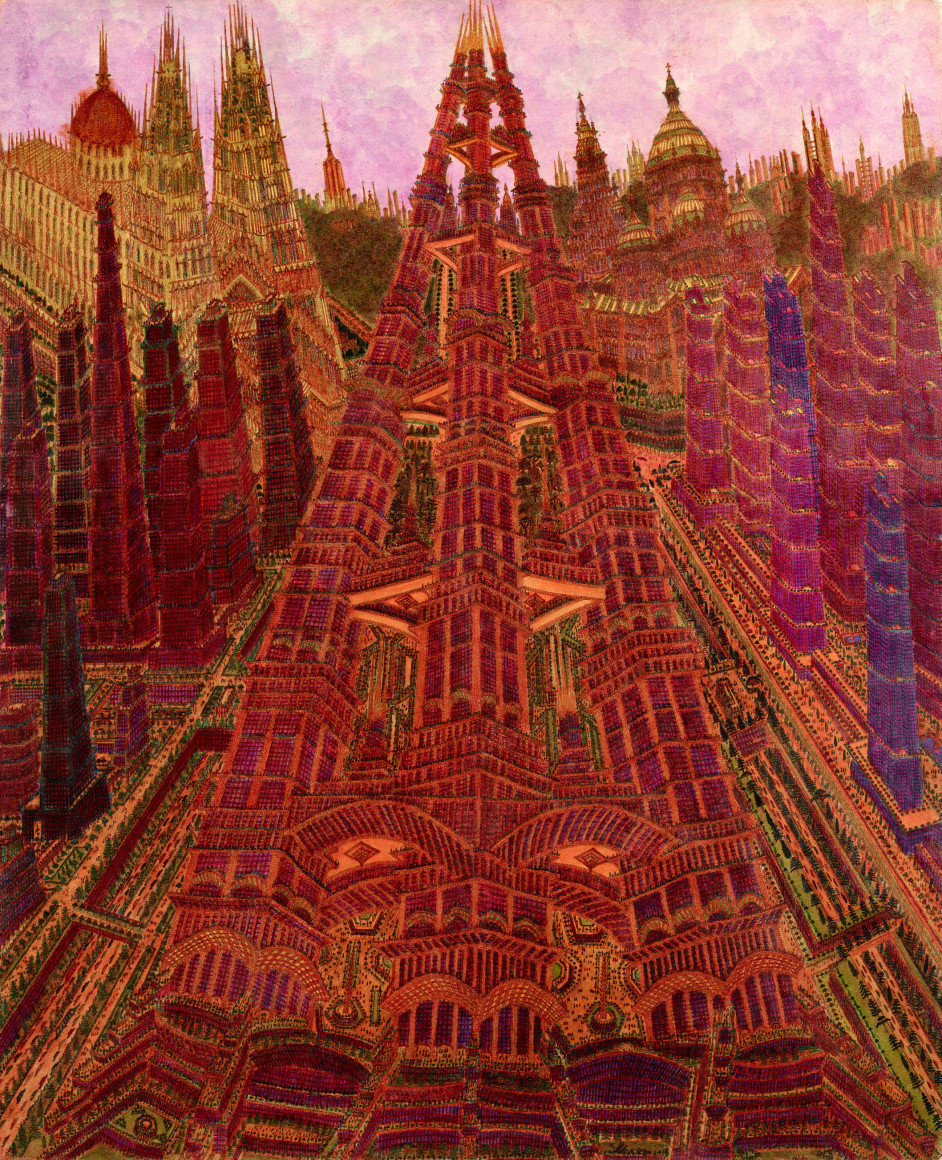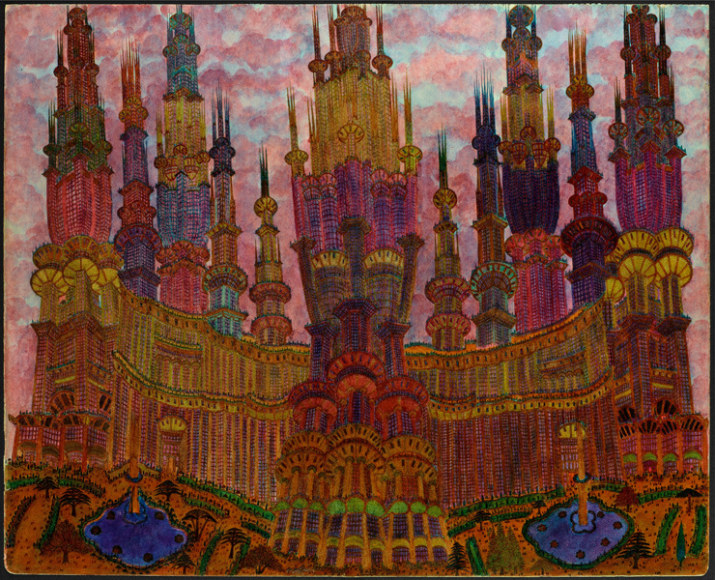Born 1911, Paris, FR
Died 1976, Paris, FR
Born in Paris, Storr was abandoned at the age of two and endured a difficult childhood. He was sent to work on farms and eventually packed off to Alsace to be cared for by nuns. By 1932, he had begun creating his first drawings of churches, but his art-making was a deeply personal, secretive activity. In time, Storr became increasingly deaf. He also suffered from psychiatric ailments about which not much is known today. He supported himself by doing odd jobs and in the mid-1940s worked at the Les Halles food market in Paris. Almost two decades later, he married and became a street sweeper in the Bois de Boulogne, the large public park in the western part of the French capital.
Meanwhile, Storr’s artwork was developing through several distinctly visible phases. Until the early 1960s, the pictures he had made of churches were marked by attention to details and an effort to portray his subject matter with a certain realism. During the late 1960s, his drawings grew larger; in them, Storr began depicting fantasy structures of imposing scale and character, including palatial cathedrals whose forms brought to mind such icons of religious architecture as the Basilique du Sacré Coeur in Paris or the Hagia Sophia in Istanbul. Storr first worked in pencil, and then filled in his drawings with ink.
Storr produced his last related group of pictures during the final decade of his life. Now known as “The Megalopolises,” these works depict delirious agglomerations of towering, ziggurat-like structures connected by buttress-bridges, as well as otherworldly urban vistas, often set against dramatically colored skies. Storr believed that Paris would one day be destroyed in a nuclear attack and that the President of the United States would need his drawings to rebuild the capital. Rich affinities between Storr’s creations and other art or architectural forms abound, including their unwitting allusions to the temples of Angkor Wat, Cambodia, images of future cities in sci-fi films and cartoons, and the elaborate, richly textured “Ideal Palace,” a large, outdoor sculpture the postman Ferdinand Cheval (1836-1924) constructed of found stones in southeastern France.
In 1971, the Parisian couple, Bertrand and Liliane Kempf, discovered Storr’s work, which the artist’s wife had shown them. In his lifetime, Storr produced a total of 63 known pictures, all of which the Kempfs acquired after his death. Some of the works were publicly displayed for the first time ever in 2001 in an exhibition at Halle Saint-Pierre in Paris. Later, the French art historian Laurent Danchin organized a solo exhibition which opened at the Pavillon Carré de Baudouin in Paris in 2011. In the summer of 2013, a major selection of Storr’s drawings was featured in the “The Alternative Guide to the Universe,” which was presented at the Hayward Gallery in London.
SELECTED EXHIBITIONS
2019
Souvenirs de Voyage. La Collection Antoine de Galbert., Musée de Grenoble, Grenoble, France
Doors of Perception, Curated by Javier Téllez in collaboration with the Outsider Art Fair, Frieze New York
2018
Marcel Storr: Mysterium Tremendum, Andrew Edlin Gallery, New York, NY
2017 - 2018
The Museum of Everything Exhibition #7, MONA (The Museum of Old and New Art), Tasmania, Australia
2016
The Museum of Everything Exhibition #6, Kunsthal Rotterdam, Netherlands
World Made By Hand, Andrew Edlin Gallery, New York, NY
2014
Marcel Storr: Reimagining Paris, Andrew Edlin Gallery, New York
2013
Vues d'en haut: Collection Liliane et Bertrand Kempf, Centre Pompidou-Metz, Metz, France
The Alternative Guide to the Universe, Hayward Gallery, London, United Kingdom
2012
Marcel Storr: Bâtisseur Visionnaire, Curated by Laurent Danchin, Pavillon Carré de Baudouin, Paris, France
2010
Les Territoires de l'Art Modeste, Musée International des Arts Modestes, Sète, France
2007
Magic Architecture, INSITA 2007, Slovak National Gallery, Bratislava, Slovakia
2005
Marcel Storr, La Mairie du IXe Arrondissement de Paris, Paris, France
2001
Aux Frontières de l’Art Brut No. 2, Halle Saint Pierre, Paris
SELECTED COLLECTIONS
Centre Georges Pompidou, Paris, FR
Collection Liliane & Bertrand Kempf, Paris
SELECTED BIBLIOGRAPHY
2018
Haber, John, "Eyes on the Ground," Haber Arts: Art Reviews from Around New York, November 28.
2015
Godin, Philippe, "Drawing Now, Focus sur le balayeur du bois de Boulogne," Libération, March 27.
2014
Salsbury, Britany, "Critics' Picks: Marcel Storr," ARTFORUM, October 11.
Ebony, David, "In Step with the Outsiders: The Outsider Art Fair," Art in America, May 9, 2014.
2013
Cumming, Laura, "Review: Alternative Guide to the Universe," Observer, June 15.
Danchin, Laurent, "Marcel Storr," The Alternative Guide to the Universe, exhibition catalogue, ed. Ralph Rugoff, Hayward Publishing, London.
Meier, Allison, "Psychedelic Plans for a Post-Apocalyptic Paris," Hyperallergic, June 25.
Rousseau, Valérie, "Visionary Architectures," The Alternative Guide to the Universe, exhibition catalogue, ed. Ralph Rugoff, Hayward Publishing, London.
2012
Couturier, Elisabeth, "Le rideau se lève sur Marcel Storr," Paris Match, February 23.
2011
Dagen, Philippe, "Les cathédrales imaginaires de Marcel Storr," Le Monde, December 30.
Kempf, Liliane, Bertrand Kempf, Laurent Danchin, and Françoise Cloarec, Marcel Storr, Phébus, Paris.
2010
Cloarec, Françoise, Storr, Architecte de l'ailleurs, Phébus, Paris.
2009
Danchin, Laurent, "Les basiliques et cités paranoïaques de Marcel Storr: la revanche d'un imaginaire clandestin," Les dessins à l'ère des nouveaux médias, Éditions Lelivredart, Paris.
2001
Danchin, Laurent, "Marcel Storr: Revenge of an Underground Imagination," Raw Vision, No. 36, Fall.2018
Marcel Storr: Mysterium Tremendum, Andrew Edlin Gallery, New York, NY




